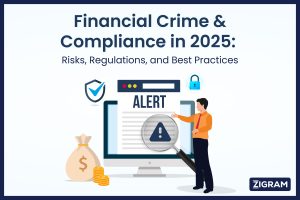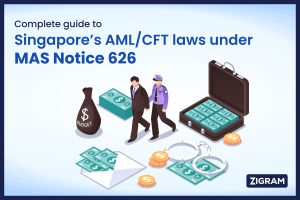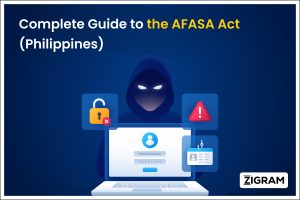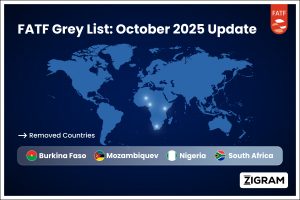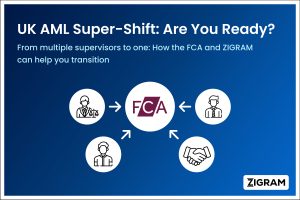Table of Contents
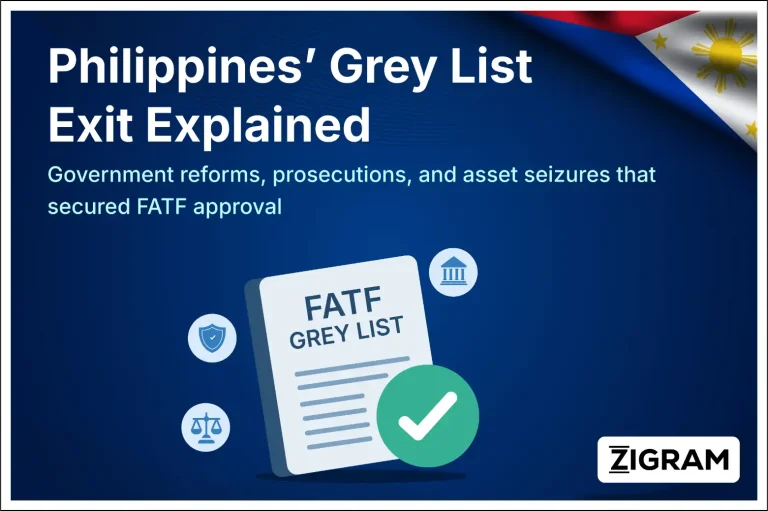
After more than three years under “increased monitoring,” the Philippines officially exited the FATF grey list in February 2025. [1] The key to this exit were government reforms, and measurable enforcement outcomes with more investigations, more prosecutions, more asset freezing and forfeiture, and improvements in supervisory and legal transparency.
In this article, we explore the measures taken by the government and what were the outcomes before and after the exit from FATF grey list.
How the Philippines Strengthened AML Compliance to Exit the FATF Grey List
The reforms that enabled the Philippines to exit the FATF grey list were wide-ranging and involved legal, regulatory, supervisory, institutional, technological, and enforcement changes. Below are the key reforms with details.
High-Level Political Commitment & Coordinated Governance
- Whole-of-government directive: On January 2, 2024, President Ferdinand Marcos Jr. issued a directive to the Anti-Money Laundering Council (AMLC) and all concerned agencies to ensure full implementation of the FATF action plan items in 2024 to trigger the country’s exit from the grey list. [2]
- National AML/CFT Strategy and Coordinating Committee (NACC): The Marcos administration established stronger coordination across government agencies National Anti-Money Laundering, Counter-Terrorism Financing, and Counter-Proliferation Financing Coordinating Committee (NACC), chaired by the Executive Secretary. This ensured centralised efforts, monitoring of progress, and a strong push for compliance across all relevant sectors. [2]
These were crucial reforms as FATF emphasises not only on legislative changes but also on reforms being effectively enforced and coordinated.
Corporate Sector Reforms and Beneficial Ownership Transparency
A large chunk of the improvements came from the Securities and Exchange Commission (SEC).
- Mandatory beneficial ownership (BO) declarations: Since 2019, the SEC mandatedcompanies to declare beneficial owners via their General Information Sheets. This laid a legal foundation for corporate transparency. [2]
- Ban on bearer shares and their warrants: In 2021, via SEC Memorandum Circular No. 1, Series of 2021, the SEC prohibited issuance and sale of bearer shares and bearer share warrants to reduce opportunities for anonymity and misuse of corporate vehicles. [2]
- Amnesty program to catch up: Recognising that many companies had lagged in complying with reportorial requirements, the SEC implemented an amnesty in 2023. Under this program, corporations could comply late with reduced penalties or waivers, which substantially increased compliance rates. By February 2025, compliance with BO information disclosure among active and registered companies rose from ~26 % (in 2021) to ~69 %. [2]
- Project HARBOR — BO Registry: To improve data collection, management, transparency, and accessibility:
- Name & purpose: Hierarchical Applicable Relations and Beneficial Ownership Registry (Project HARBOR), a digital registry for beneficial ownership information. [2]
- Features: [2]
- Automated data validation — data checked for consistency/errors.
- Configurable access levels for authorised users — ensure data security and proper sharing among agencies.
- Analytical tools for identifying complex ownership structures — detect shell companies, layered ownership etc.
- Integration with existing company registration system (eSPARC – Electronic Simplified Processing of Application for Registration of Companies)– avoids duplication and ensures corporate registration and BO disclosure are linked.
These reforms significantly improved the accuracy, timeliness, and availability of beneficial ownership information for supervisory and enforcement purposes.
Supervision and Regulation of Non-Financial and Financial Sectors
- Designated Non-Financial Businesses and Professions (DNFBPs) supervision:
- This includes entities such as real estate brokers, casinos, gambling operators, legal professionals, accountancy, consultants. The Philippines strengthened risk-based supervision of DNFBPs, ensuring they apply AML/CFT controls as per FATF standards. Casinos and particularly casino junkets—which were identified as high risk—received special attention. [3]
- Casinos including casino junkets:
- Authorities took actions to mitigate risks associated with “casino junkets” (operators that bring in high-roller gamblers, sometimes via intermediaries). The FATF/Philippines noted that supervisors are now using AML/CFT controls to mitigate risks in this space. [1]
- Money or Value Transfer Services (MVTS), remittance, illegal/unregistered remittance operators:
Law Enforcement, Financial Intelligence, Investigations & Prosecutions
- More financial intelligence usage: AMLC and other agencies showed an increase in the use of financial intelligence (e.g. suspicious transaction reports, analytics) in identifying cases. The improved use of FIU outputs was recognised in FATF’s decision. [9]
- Increase in ML / TF investigations and prosecutions: The Philippines improved its investigations and prosecutions of money laundering in a way that is proportional to risk. There was also better handling of terrorist financing cases. FATF noted an increase in identification, investigation, and prosecution of such cases. [3]
- Access to Beneficial Ownership Information by law enforcement: Improving legal/regulatory regimes so that authorities can access BO information in accurate, up-to-date form, with fewer bureaucratic or structural obstacles. [3]
Targeted Financial Sanctions, Non-Profit Organisations, Cross-Border Measures
- Strengthened targeted financial sanctions: Measures were improved for both terrorism financing (TF) and proliferation financing. This includes better legal/regulatory framework, enforcement, and ensuring sanctions are applied. [3]
- Non-Profit Organisations (NPOs):
- Identification of high-risk NPOs, annual audits of some high-risk NPOs. SEC audits ~50 high-risk NPOs annually since 2022, ensuring compliance. [2]
- Encourage registration of unregistered NPOs — public campaign, outreach, registration drives. Since 2021, nearly 7,600–8,000 NPOs have been registered that were previously unregistered. [2]
- Ensuring that regulatory oversight does not unduly disrupt legitimate NPO activity. Regulatory balancing. [1]
- Cross-border measures:
- Improved implementation at international sea/air ports: customs, immigration, or border authorities are implementing measures consistent with risk assessments to ensure illicit funds or risks do not cross unmonitored. [3]
- Improved implementation at international sea/air ports: customs, immigration, or border authorities are implementing measures consistent with risk assessments to ensure illicit funds or risks do not cross unmonitored. [3]
Technology, Data Systems, and Integration
- Automated systems & registries: Project HARBOR has been central here, as noted above, enabling more efficient BO data collection, validation, sharing, and analysis. Integration with eSPARC as the company registration platform has been important for coherence. [2]
- Offsite and onsite inspections: The SEC and other regulatory agencies increased both offsite and onsite supervisory visits to companies, NPOs, and other covered entities. For example, more audits of NPOs, inspections of corporate compliance with BO reporting, etc. [10]
- Analytic tools / complex ownership detection: The registry and regulatory tools include features to detect complex or opaque ownership structures. This helps identify shell companies, layered ownership, etc. [2]
Sanctions, Penalties, and Enforcement
- Delinquent and inactive company management: The SEC suspended registration of more than 117,000 inactive companies and flagged about 168,000 more as delinquent. This helps clean up the corporate registry, address shell companies, reduce anonymity. [2]
- Higher penalties for non-compliance: Increased penalties for late submission of required corporate documents, failure to declare beneficial owners, etc. The amnesty program aside, going forward non-compliance is less tolerable, with stronger enforcement. [2]
Emerging Risk Areas: Virtual Assets, Crypto, Digital Platforms
- The SEC is drafting rules for Crypto-Asset Service Providers (CASPs) to bring them under supervision and apply AML/CFT controls. Since digital assets and crypto can be high risk (anonymity, cross-border flows, etc.), this has been a necessary evolution. [3]
- Oversight is being extended to “innovative financial products,” digital platforms which may facilitate scams or illicit transfers. [3]
Institutional Reforms, Legal Framework Strengthening
- Updating of laws/regulations to match FATF standards, including amendments to implementing rules or regulations of existing laws. The Anti-Financial Account Scamming Act (AFASA) is one example of recent legislation/act that improved protection of financial transactions. [3]
- Ensuring laws grant authorities necessary legal powers: e.g., access to BO information, power to impose sanctions, to cooperate internationally, etc. While some of these are regulatory rather than legislative, they have been strengthened. [3]
Key Enforcement Metrics Before and After the FATF Grey List Exit
Here are several enforcement and intelligence metrics, showing contrast with earlier periods. Note that “before” typically refers to the period up to 2019–2022, and “during/after” refers roughly to 2021-2024 (or 2020-2024 in TF cases).
| Metric | Before grey-listing / Baseline (approx. up to 2019-2022) | During / After (2021-2024) | Change / Significance |
| Investigations (ML) | Less well-documented; fewer publicly reported comprehensive figures. AMLC & DOJ reports flagged low conversion of STRs to strong investigations pre-2021. | 13,799 ML investigations conducted from 2021-2024; 5,821 of them in 2024 alone. | Sharp increase, especially in the later years; shows improved capacity and perhaps better law enforcement resourcing. |
| Investigations (TF) | Pre-grey list, fewer investigations reported publicly; AMLC’s risk assessment noted limited TF investigations up to 2021. [5] | 1,816 terrorism financing investigations from 2020-2024. [4] | Substantial scale up in TF investigations, indicating greater prioritization. |
| Court filings / ML cases filed | Before 2021-2022, fewer ML cases filed; for example, some AMLC data shows fewer than 40 ML cases filed/complaints in 2019-2022. [6] | 264 ML cases filed since 2021 via FILEPSC, with 185 filed in 2024 alone. | Big increase in case filing, especially recent surge in 2024. |
| Accused persons (ML) | Harder to locate reliable data pre-2021, though earlier assessments noted many STRs but far fewer persons actually being charged or prosecuted. | 794 individuals accused in ML cases from 2021-2024. [4] | Indicates more active case building and prosecutorial action. |
| Convictions (ML) | Before grey-list, convictions were rare, and many investigations did not result in convictions; assessors flagged this as a weak area. | At least 7 convictions secured from 2021-2024. [8] | Still small in absolute terms but a clear uptick; one prominent case is Janet Lim Napoles. [8] |
| Prosecutions (TF) | Few TF prosecutions; in earlier reports, TF was identified as weak in enforcement. | 237 TF prosecutions initiated from 2020-2024. [4] | A marked increase showing that TF enforcement has become more active. |
| Convictions (TF) | Before grey-list, convictions for TF were very few or sometimes nil, and generally low profile. | 6 persons convicted for 114 counts of terrorism financing from 2020-2024. [4] | Again, increased enforcement, though conviction numbers remain modest compared to investigations. |
| Asset freezing & civil forfeiture | Baseline: in earlier years, frozen assets and civil forfeiture values were lower; e.g., between 2019-2022, AMLC froze PHP3.81 billion; civil forfeiture was PHP1.01 billion. [6] | From 2021-2024: frozen assets PHP4.15 billion; civil forfeiture value jumped to PHP7.01 billion. [6] | Big growth especially in forfeiture powers; demonstrates better use of legal tools to seize illicit assets. |
| Transaction / Reporting Activity (CTRs & STRs) | Before grey-listing in 2019-2022: ~176.9 million CTRs; ~10.3 million STRs. [6] | From 2021-2024: ~204.76 million CTRs; ~51.56 million STRs. [6] | STR reporting especially saw a large jump (five-fold). Suggests better compliance by reporting entities and AMLC doing more analysis. |
| DNFBP registration / supervision | Before: large gaps. Number of registered DNFBPs was much lower. For example, real estate, casinos etc. had weaker oversight. | Number of registered DNFBPs rose sharply to 38,542 from just 7,165 in earlier period (2019-2022). [6] | Very large proportional increase; suggests extension of regulatory reach. |
How Enforcement Improved After the FATF Grey List Exit
These numbers tell a story of escalation and strengthening:
- More detection and reporting: The jump in STRs implies that banks, casinos, remittance / money service providers, real estate agents, etc., have become more vigilant or are being more strictly supervised. This increases the intelligence pipeline.
- More investigations, especially in high-risk sectors: The multiplication of investigations for both Money Laundering and Terror Financing, with more cases filed, which indicates that the authorities are not just observing but they are acting as well.
- Increased use of asset confiscation / forfeiture: The growth in civil forfeiture from ~PHP1.01 billion to ~PHP7.01 billion is especially significant. Freezing assets is one thing; actually forfeiting them (i.e. getting them through the courts) shows legal effectiveness. The increase in frozen assets to PHP4.15 billion (up from PHP3.81 billion) also shows incremental growth in preventing assets being moved away or hidden. [6]
- Legal tools & institutional reforms: Beneficial ownership disclosure, stricter supervision of DNFBPs (casinos, MVTS), regulatory reforms at the SEC, stricter penalties and better compliance culture. [2]
- Terrorism Financing (TF) finally treated more aggressively: Before, TF was often neglected relative to ML; after reforms there were many more investigations, more prosecutions, arrests, and some convictions. Though convictions are still modest, the pipeline is stronger. Also, this was part of the action plan that the FATF required. [4]
Remaining Gaps and Challenges After the FATF Grey List Exit
Even though the Philippines has made large strides, the comparison also reveals some areas which still need improvement.
- Conviction rate vs scale: While investigations and prosecutions have risen greatly, conviction numbers (especially for TF) remain low in proportion to investigations. There is a lag between investigatory activity and actual court judgements, which is expected, but the proportional gap is still noticeable.
- Quality and speed: Convictions like those in high-profile cases often take time (pleadings, trials, evidence). Speed of processing, reducing delays, and improving evidence gathering remain ongoing concerns.
- Backlogs & pending litigation: Many forfeitures are under litigation or are frozen but not yet confiscated permanently. Also, judicial delays remain an issue, especially in older cases.
- Risk coverage: Some sectors remain higher risk (junket operators in casinos, some MVTS / remittance operators, parts of DNFBPs) and oversight has improved but constant vigilance is needed.
- Sustainability of reforms: Exiting the grey list is one milestone; maintaining regulatory, supervisory, and enforcement pressure, especially with changing typologies of financial crime, is crucial so as not to relapse. Also, vigilance in cross-border cooperation remains key.
Conclusion
Comparing enforcement before vs after the grey-listing period shows that the Philippines has made significant progress in AML/CFT:
- Through higher volumes of investigations, more prosecutions filed, and better use of legal tools like asset freezing and forfeiture.
- Through improvements in financial intelligence (STRs, CTRs), regulatory reach (DNFBP registration increases), and transparency (beneficial ownership reforms).
- Through measurable results in convictions, even if modest in absolute terms, especially for terrorism financing.
These outcomes were central to FATF’s decision to remove the Philippines from the grey list. The journey illustrates that strong laws alone are not enough- operational enforcement, improved supervision, and institutional coordination matter. Going forward, their aim should be to maintain and build upon the progress, close remaining gaps (especially in convictions and risk coverage), and ensure the system remains adaptive to evolving threats.
Bibliography
1. PH exits FATF’S ‘grey list’ – (Philippine News Agency)
2. SEC reforms key to Philippines’ FATF grey list exit – (Manila Bulletin)
3. Philippines exits FATF money laundering ‘gray list’ – (Philstar)
4. DOJ attributes PHL’s ‘grey list’ exit to ongoing effort to fight money laundering and terrorism financing activities – (BusinessMirror)
5. AMLC expects more investigations into terrorism financing – (BusinessWorld Online)
6. AMLC ramps up crackdown, freezes P4.1 billion in 3 years – (Philstar)
7. 264 money laundering cases filed in courts since 2021 — DOJ – (Manila Bulletin)
8. DOJ secures 7 money laundering convictions in 2021-2024 – (GMA Network)
- #GENIUSAct
- #Stablecoins
- #AML
- #FinancialCrime
- #Compliance
- #CryptoRegulation
- #FinCEN
- #SanctionsCompliance
- #RegTech
- #AntiMoneyLaundering
- #DigitalAssets
- #FinancialSecurity

